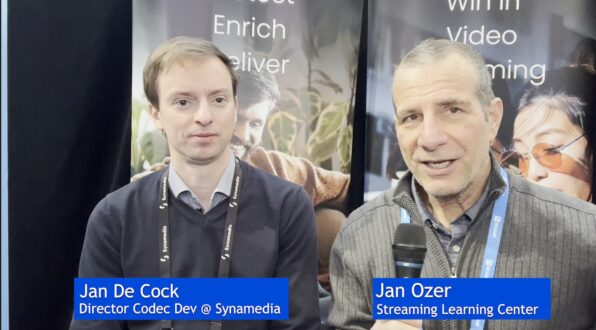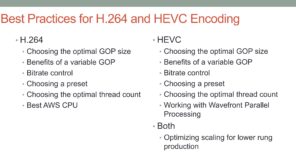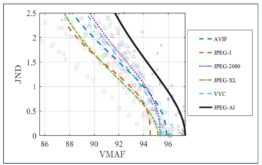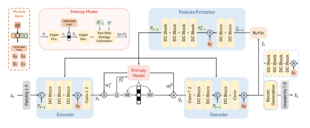At Mile High Video 2025, I sat down with Synamedia’s Jan De Cock to discuss the latest advancements in video quality measurement, VVC adoption trends, and Synamedia’s commitment to open-source contributions. You can watch the interview on YouTube here, embedded below. Some of Jan’s comments are edited slightly for readability.
Contents
Synamedia’s Role in Video Solutions
Synamedia is a global provider of end-to-end video solutions, from video ingest to primary distribution. Jan explained, “My focus is mostly on the compression, the encoding, and transcoding part, but we also have our very own CDN delivery networks.” At Mile High Video, Synamedia showcased innovations in CDN technology and video quality measurement, particularly for live video distribution. Jan noted that Synamedia is achieving its goal of being a global leader in live video, underscoring the company’s commitment to innovation and quality.
Open-Source VMAF Predictors and SVT-AV1 Integration
Synamedia is well-known for its open-source contributions, and Jan highlighted their ongoing work on VMAF predictors. “We’ve worked on our very own VMAF predictor, first for x264,” Jan explained. At Mile High Video, he announced the expansion of this work for the SVT-AV1 encoder.
This new functionality allows real-time VMAF prediction during encoding, enabling 24/7 video quality tracking with almost no computational overhead. “You can now get frame-by-frame predicted VMAF values with just a command line option,” Jan said. The innovation correlates highly with traditional VMAF calculations, reaching the upper 90s percentile in correlation coefficients.
VMAF NEG Model: Ensuring Fair Encoder Comparison
Jan Ozer asked Jan De Cock about the VMAF NEG (No Enhancement Gain) model. As De Cock explained, this model detects when pre-processing or encoding tricks artificially inflate VMAF scores, ensuring fair and objective encoder comparisons. Jan advised, “If you want an apples-to-apples comparison between encoders, you want to exclude these effects. The VMAF NEG model helps detect any tweaking that might be going on.”
This model benefits companies by allowing them to evaluate multiple encoders without falling victim to artificial quality boosts. “If the BD rates are very different between VMAF NEG and regular VMAF, then something fishy might be going on,” Jan noted.
VVC Adoption and Regional Trends
Jan also shared his insights into VVC (Versatile Video Coding) adoption trends, emphasizing the geographic variability in adoption rates. “VVC adoption is still in the early exploration phase, but it’s quite geographically dependent,” Jan explained. He noted that China will likely be among the first countries to adopt VVC. Additionally, Brazil’s TV 3.0 initiative includes VVC in its codec toolbox, indicating more concrete interest in that region.
Despite this, Jan observed that interest levels vary significantly worldwide, with some regions focused solely on exploratory testing. This geographic diversity suggests that VVC’s adoption path will not be uniform across global markets.
Open-Sourcing and Industry Collaboration
The conversation then turned to open source, where Synamedia actively participates in developing VMAF predictors and other video quality tools. Jan explained the strategic value of open sourcing: “It’s about encouraging the ecosystem and driving innovation in video quality.” Synamedia’s contributions are mainly focused on live video distribution, an area that still faces significant challenges compared to Video on Demand (VOD).
By open-sourcing these tools, Synamedia not only advances its own technology but also fosters industry-wide improvements in video quality measurement and encoding efficiency.
Why Mile High Video Matters
Jan has attended Mile High Video three times and appreciates its blend of industry and academic perspectives. “It strikes a good balance between industry interest and academic research,” he said. He highlighted the event’s focus on the entire video delivery chain, from coding to distribution, as a key reason for its value. “It’s not just about video coding but also about the delivery side,” Jan noted.
He also emphasized the importance of networking with industry peers and gaining insights into the latest research and innovations. “It provides a good representation of the whole video ecosystem,” Jan observed, making Mile High Video an essential conference for staying at the forefront of video technology.
Conclusion
Jan De Cock’s insights provide a comprehensive look into Synamedia’s advancements in video quality measurement, codec adoption trends, and open-source contributions. For more insights, check out the full interview or visit Synamedia’s website to learn more about their video solutions.
 Streaming Learning Center Where Streaming Professionals Learn to Excel
Streaming Learning Center Where Streaming Professionals Learn to Excel










